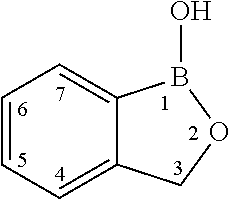Boron-containing small molecules as Anti-protozoal agent
a small molecule and protozoa technology, applied in the field of small molecule boron-containing boron-containing agents as antiprotozoal agents, can solve the problems of global rise of protozoa resistant to antimicrobials in general, and pose a major threa
- Summary
- Abstract
- Description
- Claims
- Application Information
AI Technical Summary
Benefits of technology
Problems solved by technology
Method used
Image
Examples
example 1
M1. 4-Fluoro-N-(1-hydroxy-3,4-dihydro-1H-benzo[c][1,2]oxaborinin-7-yl)-2-trifluoromethyl-benzamide
[0229]
[0230]To a solution of 2-(2-bromo-phenyl)-ethanol (5.0 g, 24.9 mmol, 1.0 eq) in DCM (100 mL) was added 3,4-dihydro-2H-pyran (3.4 mL, 37.3 mmol, 1.5 eq.), followed by camphorsulfonic acid (2100 mg). The mixture was stirred at room temperature for 2 h. After adding K2CO3 (300 mg), the mixture was filtered to remove the precipitate, the filtrate was washed with H2O (100 mL), brine (100 mL). The organic phase was dried over MgSO4, filtered and the filtrate was concentrated under reduced pressure. The oily residue was applied to silica chromatography eluting with EtOAc / Heptanes (0:100 to 50:50) to give 2-[2-(2-bromo-phenyl)-ethoxy]-tetrahydro-pyran as a colorless oil. 1H NMR (chloroform-d) δ: 7.48-7.54 (m, 1H), 7.25-7.30 (m, 1H), 7.17-7.23 (m, 1H), 7.01-7.09 (m, 1H), 4.56-4.61 (m, 1H), 3.88-3.97 (m, 1H), 3.58-3.67 (m, 1H), 3.04 (t, J=7.2 Hz, 2H), 1.62-1.67 (m, 1H), 1.41-1.60 (m, 5H), 0...
example 2
Trypanosoma brucei brucei High-Throughput Screening Assay Procedure
[0363]All experiments were conducted with the bloodstream-form trypanosome T. brucei brucei 427 strain. Parasites were cultured in T-25 vented cap flasks and kept in humidified incubators at 37° C. and 5% CO2. The parasite culture media was complete HMI-9 medium (c.f. Hirumi, Journal of Parasitology 1989, Volume 75, page 985 et seq) containing 10% FBS, 10% Serum Plus medium and penicillin / streptomycin. To ensure log growth phase, trypanosomes were sub-cultured at appropriate dilutions every 2-3 days.
In Vitro Drug Sensitivity Assays
[0364]Log phase cultures were diluted 1:10 in HMI-9 and 10 uL was counted using hemocytometer to determine parasite concentration. Parasites were diluted to 2×105 / mL in HMI-9 to generate a 2-fold working concentration for assay. Compounds to be tested were serially diluted in DMSO and 0.5 uL added to 49.5 uL HMI-9 in triplicate 96-well plates using a Biomek NX liquid handler. Parasites from...
example 3
L929 Cells and Cultivation
[0366]For evaluation of compound effects on mammalian cells, L929 mouse fibroblast cells were used. Cells were maintained as adherent cultures in T-25 vented cap flasks in a humidified incubator at 37° C. in the presence of 5% CO2. Culture media was D-MEM supplemented with 10% fetal bovine serum and 1% penicillin / streptomycin. L929 cells were maintained below confluent levels by sub-culturing at 1:10 dilution twice weekly using 0.05% trypsin for detachment.
Cytotoxicity Evaluation
[0367]Sub-confluent L929 cells were trypsinized, resuspended in fresh media and 10 uL was counted using hemocytometer to determine cell concentration. Cells were diluted to 1×104 / mL in DMEM, dispensed (100 uL) into 96-well plates using a Multidrop 384 dispenser and allowed to attach overnight. Spent media was replaced with 99.5 uL fresh D-MEM and compounds to be tested were serially diluted in DMSO and 0.5 uL added using a Biomek NX liquid handler. Plates were incubated with compoun...
PUM
 Login to View More
Login to View More Abstract
Description
Claims
Application Information
 Login to View More
Login to View More - R&D
- Intellectual Property
- Life Sciences
- Materials
- Tech Scout
- Unparalleled Data Quality
- Higher Quality Content
- 60% Fewer Hallucinations
Browse by: Latest US Patents, China's latest patents, Technical Efficacy Thesaurus, Application Domain, Technology Topic, Popular Technical Reports.
© 2025 PatSnap. All rights reserved.Legal|Privacy policy|Modern Slavery Act Transparency Statement|Sitemap|About US| Contact US: help@patsnap.com



